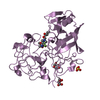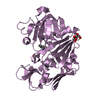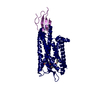+Search query
-Structure paper
| Title | A µ-opioid receptor modulator that works cooperatively with naloxone. |
|---|---|
| Journal, issue, pages | Nature, Year 2024 |
| Publish date | Jul 3, 2024 |
 Authors Authors | Evan S O'Brien / Vipin Ashok Rangari / Amal El Daibani / Shainnel O Eans / Haylee R Hammond / Elizabeth White / Haoqing Wang / Yuki Shiimura / Kaavya Krishna Kumar / Qianru Jiang / Kevin Appourchaux / Weijiao Huang / Chensong Zhang / Brandon J Kennedy / Jesper M Mathiesen / Tao Che / Jay P McLaughlin / Susruta Majumdar / Brian K Kobilka /    |
| PubMed Abstract | The µ-opioid receptor (µOR) is a well-established target for analgesia, yet conventional opioid receptor agonists cause serious adverse effects, notably addiction and respiratory depression. These ...The µ-opioid receptor (µOR) is a well-established target for analgesia, yet conventional opioid receptor agonists cause serious adverse effects, notably addiction and respiratory depression. These factors have contributed to the current opioid overdose epidemic driven by fentanyl, a highly potent synthetic opioid. µOR negative allosteric modulators (NAMs) may serve as useful tools in preventing opioid overdose deaths, but promising chemical scaffolds remain elusive. Here we screened a large DNA-encoded chemical library against inactive µOR, counter-screening with active, G-protein and agonist-bound receptor to 'steer' hits towards conformationally selective modulators. We discovered a NAM compound with high and selective enrichment to inactive µOR that enhances the affinity of the key opioid overdose reversal molecule, naloxone. The NAM works cooperatively with naloxone to potently block opioid agonist signalling. Using cryogenic electron microscopy, we demonstrate that the NAM accomplishes this effect by binding a site on the extracellular vestibule in direct contact with naloxone while stabilizing a distinct inactive conformation of the extracellular portions of the second and seventh transmembrane helices. The NAM alters orthosteric ligand kinetics in therapeutically desirable ways and works cooperatively with low doses of naloxone to effectively inhibit various morphine-induced and fentanyl-induced behavioural effects in vivo while minimizing withdrawal behaviours. Our results provide detailed structural insights into the mechanism of negative allosteric modulation of the µOR and demonstrate how this can be exploited in vivo. |
 External links External links |  Nature / Nature /  PubMed:38961287 PubMed:38961287 |
| Methods | EM (single particle) |
| Resolution | 3.26 Å |
| Structure data | EMDB-44635, PDB-9bjk: |
| Chemicals |  PDB-1apv:  PDB-1apu: |
| Source |
|
 Keywords Keywords | MEMBRANE PROTEIN / G-protein coupled receptor / inactive / opioid / allosteric modulator |
 Movie
Movie Controller
Controller Structure viewers
Structure viewers About Yorodumi Papers
About Yorodumi Papers






